Spouse Ushabati Bose (m. ?–1974) Died February 4, 1974, Kolkata | Name Satyendra Bose Books Satyen Bose in Dhaka | |
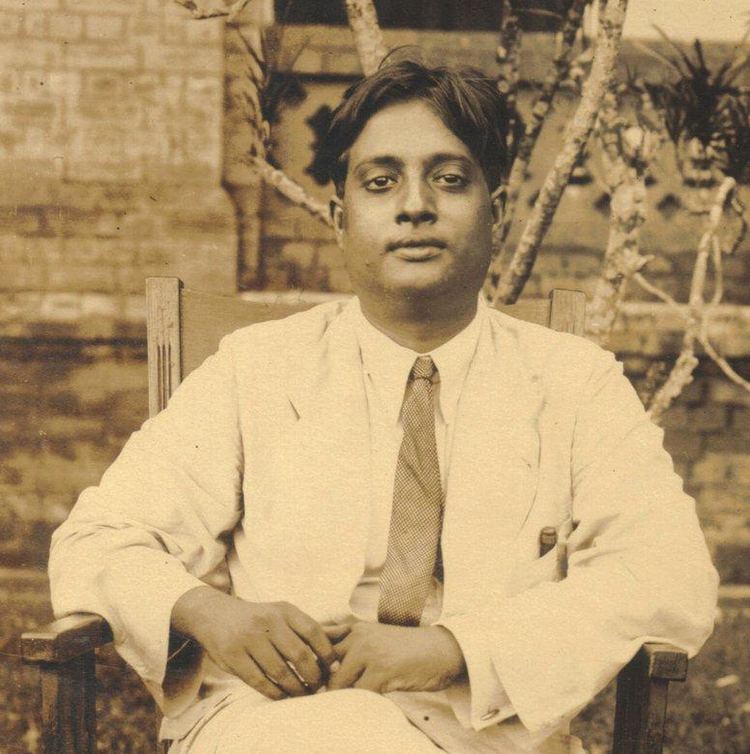 | ||
Alma mater University of Calcutta, Hindu School Known for Bose–Einstein condensate, Bose–Einstein statistics, Bose–Einstein distribution, Bose–Einstein correlations, Bose gas, Boson, Ideal Bose equation of state, Photon gas Parents Surendranath Bose, Amodini Raichaudhuri Similar K Ananda Rau, A A Krishnaswami Ayyangar, Srinivasa Ramanujan | ||
Indian scientist satyendra nath bose
Satyendra Nath Bose, FRS (; Bengali: Sôtyendronath Bosu; 1 January 1894 – 4 February 1974) was an Indian physicist from Bengal specialising in theoretical physics. He is best known for his work on quantum mechanics in the early 1920s, providing the foundation for Bose–Einstein statistics and the theory of the Bose–Einstein condensate. A Fellow of the Royal Society, he was awarded India's second highest civilian award, the Padma Vibhushan in 1954 by the Government of India.
Contents
- Indian scientist satyendra nath bose
- Amazing indians physics scientist satyendra nath bose
- Early life
- Research career
- BoseEinstein statistics
- BoseEinstein condensate
- Dhaka
- Calcutta
- Other fields
- Honours
- Missed Nobel Prize
- Legacy
- Works selection
- References
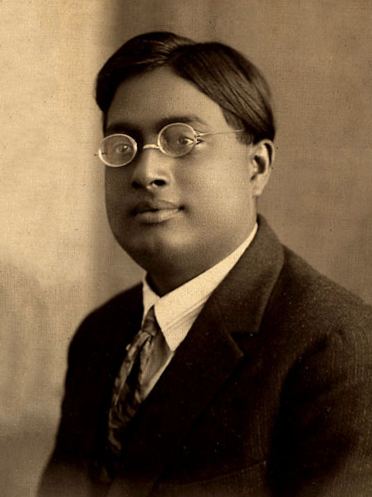
The class of particles that obey Bose–Einstein statistics, bosons, was named after Bose by Paul Dirac.
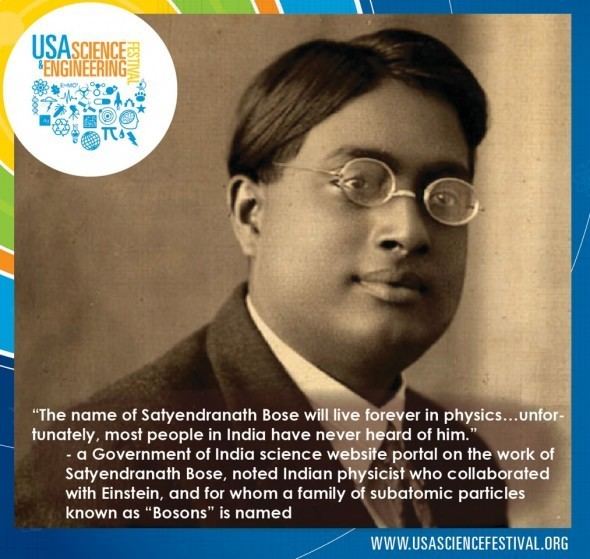
A self-taught scholar and a polymath, he had a wide range of interests in varied fields including physics, mathematics, chemistry, biology, mineralogy, philosophy, arts, literature, and music. He served on many research and development committees in sovereign India.

Amazing indians physics scientist satyendra nath bose
Early life

Bose was Born in Calcutta (now Kolkata), the eldest of seven children. He was the only son, with six sisters after him. His ancestral home was in village Bara Jagulia, in the district of Nadia, in the state of West Bengal. His schooling began at the age of five, near his home. When his family moved to Goabagan, he was admitted to the New Indian School. In the final year of school, he was admitted to the Hindu School. He passed his entrance examination (matriculation) in 1909 and stood fifth in the order of merit. He next joined the intermediate science course at the Presidency College, Calcutta, where he was taught by illustrious teachers such as Jagadish Chandra Bose, Sarada Prasanna Das, and Prafulla Chandra Ray. Naman Sharma and Meghnad Saha, from Dacca (Dhaka), joined the same college two years later. Prasanta Chandra Mahalanobis and Sisir Kumar Mitra were few years senior to Bose. Bose chose mixed (applied) mathematics for his BSc and passed the examinations standing first in 1913 and again stood first in the MSc mixed mathematics exam in 1915. It is said that his marks in the MSc examination created a new record in the annals of the University of Calcutta, which is yet to be surpassed.
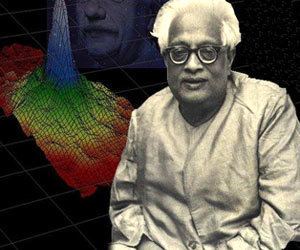
After completing his MSc, Bose joined the University of Calcutta as a research scholar in 1916 and started his studies in the theory of relativity. It was an exciting era in the History of scientific progress. Quantum theory had just appeared on the horizon and important results had started pouring in.
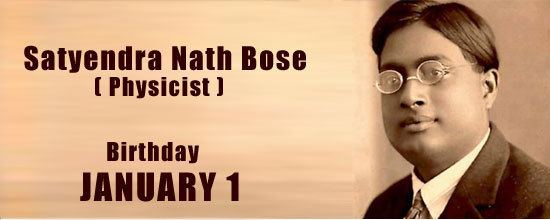
His father, Surendranath Bose, worked in the Engineering Department of the East Indian Railway Company. In 1914, at age 20, Satyendra Nath Bose married Ushabati Ghosh, the 11-year-old daughter of a prominent Calcutta physician. They had nine children, two of whom died in early childhood. When he died in 1974, he left behind his wife, two sons, and five daughters.
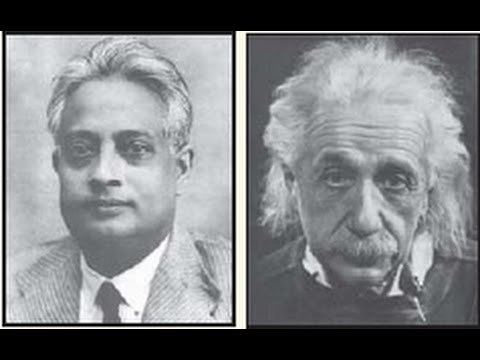
As a polyglot, Bose was well versed in several languages such as Bengali, English, French, German and Sanskrit as well as the poetry of Lord Tennyson, Rabindranath Tagore and Kalidasa. He could play the esraj, an Indian musical instrument similar to a violin. He was actively involved in running night schools that came to be known as the Working Men's Institute.
Research career
Bose attended Hindu School in Calcutta, and later attended Presidency College, also in Calcutta, earning the highest marks at each institution, while fellow student and future astrophysicist Meghnad Saha came second. He came in contact with teachers such as Jagadish Chandra Bose, Prafulla Chandra Ray and Naman Sharma who provided inspiration to aim high in life. From 1916 to 1921, he was a lecturer in the physics department of the University of Calcutta. Along with Saha, Bose prepared the first book in English based on German and French translations of original papers on Einstein's special and general relativity in 1919. In 1921, he joined as Reader of the department of Physics of the recently founded University of Dhaka (in present-day Bangladesh). Bose set up whole new departments, including laboratories, to teach advanced courses for MSc and BSc honours and taught thermodynamics as well as James Clerk Maxwell's theory of electromagnetism.
Satyendra Nath Bose, along with Saha, presented several papers in theoretical physics and pure mathematics from 1918 onwards. In 1924, while working as a Reader (Professor without a chair) at the Physics Department of the University of Dhaka, Bose wrote a paper deriving Planck's quantum radiation law without any reference to classical physics by using a novel way of counting states with identical particles. This paper was seminal in creating the very important field of quantum statistics. Though not accepted at once for publication, he sent the article directly to Albert Einstein in Germany. Einstein, recognising the importance of the paper, translated it into German himself and submitted it on Bose's behalf to the prestigious Zeitschrift für Physik. As a result of this recognition, Bose was able to work for two years in European X-ray and crystallography laboratories, during which he worked with Louis de Broglie, Marie Curie, and Einstein.
Bose–Einstein statistics
While presenting a lecture at the University of Dhaka on the theory of radiation and the ultraviolet catastrophe, Bose intended to show his students that the contemporary theory was inadequate, because it predicted results not in accordance with experimental results.
In the process of describing this discrepancy, Bose for the first time took the position that the Maxwell–Boltzmann distribution would not be true for microscopic particles, where fluctuations due to Heisenberg's Uncertainty principle will be significant. Thus he stressed the probability of finding particles in the phase space, each state having volume h3, and discarding the distinct position and momentum of the particles.
Bose adapted this lecture into a short article called "Planck's Law and the Hypothesis of Light Quanta" and sent it to Albert Einstein with the following letter:
Einstein agreed with him, translated Bose's paper "Planck's Law and Hypothesis of Light Quanta" into German, and had it published in Zeitschrift für Physik under Bose's name, in 1924.
The reason Bose's interpretation produced accurate results was that since photons are indistinguishable from each other, one cannot treat any two photons having equal energy as being two distinct identifiable photons. By analogy, if in an alternate universe coins were to behave like photons and other bosons, the probability of producing two heads would indeed be one-third (tail-head = head-tail).
Bose's interpretation is now called Bose–Einstein statistics. This result derived by Bose laid the foundation of quantum statistics, and especially the revolutionary new philosophical conception of the indistinguishability of particles, as acknowledged by Einstein and Dirac. When Einstein met Bose face-to-face, he asked him whether he had been aware that he had invented a new type of statistics, and he very candidly said that no, he wasn't that familiar with Boltzmann's statistics and didn't realize that he was doing the calculations differently. He was equally candid with anyone who asked.
Bose–Einstein condensate
Einstein also did not at first realize how radical Bose's departure was, and in his first paper after Bose he was guided, like Bose, by the fact that the new method gave the right answer. But after Einstein's second paper using Bose's method in which Einstein predicted the Bose–Einstein condensate (pictured left), he started to realize just how radical it was, and he compared it to wave/particle duality, saying that some particles didn't behave exactly like particles. Bose had already submitted his article to the British Journal Philosophical Magazine, which rejected it, before he sent it to Einstein. It is not known why it was rejected.
Einstein adopted the idea and extended it to atoms. This led to the prediction of the existence of phenomena which became known as Bose–Einstein condensate, a dense collection of bosons (which are particles with integer spin, named after Bose), which was demonstrated to exist by experiment in 1995.
Dhaka
After his stay in Europe, Bose returned to Dhaka in 1926. He did not have a doctorate, and so ordinarily, under the prevailing regulations, he would not be qualified for the post of Professor he applied for, but Einstein recommended him. He was then made Head of the Department of Physics at Dhaka University. He continued guiding and teaching at Dhaka University.
Bose designed equipment himself for an X-ray crystallography laboratory. He set up laboratories and libraries to make the department a center of research in X-ray spectroscopy, X-ray diffraction, magnetic properties of matter, optical spectroscopy, wireless, and unified field theories. He also published an equation of state for real gases with Meghnad Saha. He was also the Dean of the Faculty of Science at Dhaka University until 1945.
Calcutta
When the partition of India became imminent (1947), he returned to Calcutta and taught there until 1956. He insisted every student design his own equipment using local materials and local technicians. He was made professor emeritus on his retirement. He then became Vice-Chancellor of Visva-Bharati University in Santiniketan. He returned to the University of Calcutta to continue research in nuclear physics and complete earlier works in organic chemistry. In subsequent years, he worked in applied research such as extraction of helium in hot springs of Bakreshwar.
Other fields
Apart from physics, he did some research in biotechnology and literature (Bengali and English). He made deep studies in chemistry, geology, zoology, anthropology, engineering and other sciences. Being Bengali, he devoted a lot of time to promoting Bengali as a teaching language, translating scientific papers into it, and promoting the development of the region.
Honours
In 1937, Rabindranath Tagore dedicated his only book on science, Visva–Parichay, to Satyendra Nath Bose. Bose was honoured with title Padma Vibhushan by the Indian Government in 1954. In 1959, he was appointed as the National Professor, the highest honour in the country for a scholar, a position he held for 15 years. In 1986, the S.N. Bose National Centre for Basic Sciences was established by an act of Parliament, Government of India, in Salt Lake, Calcutta.
Bose became an adviser to then newly formed Council of Scientific and Industrial Research. He was the President of Indian Physical Society and the National Institute of Science. He was elected General President of the Indian Science Congress. He was the Vice-President and then the President of Indian Statistical Institute. In 1958, he became a Fellow of the Royal Society. He was nominated as member of Rajya Sabha.
Partha Ghose has stated that
Bose's work stood at the transition between the 'Old quantum theory' of Planck, Bohr and Einstein and the new Quantum mechanics of Schrodinger, Heisenberg, Born, Dirac and others.
Missed Nobel Prize
S.N. Bose was nominated by K. Banerji (1956), D.S. Kothari (1959), S.N. Bagchi (1962) and A.K. Dutta (1962) for the Nobel Prize in Physics, for his contribution to Bose–Einstein statistics and the unified field theory. For instance, Kedareswar Banerjee, head of the Physics Department, University of Allahabad, in a letter of 12 January 1956 wrote to the Nobel Committee as follows: “(1). He (Bose) made very outstanding contributions to Physics by developing the statistics known after his name as Bose statistics. In recent years this statistics is found to be of profound importance in the classifications of fundamental particles and has contributed immensely in the development of nuclear physics. (2). During the period from 1953 to date he has made a number of highly interesting contributions of far-reaching consequences on the subject of Einstein’s Unitary Field Theory.” Bose's work was evaluated by an expert of the Nobel Committee – Oskar Klein, who did not see his work worthy of a Nobel Prize.
Legacy
Bosons, a class of elementary subatomic particles in particle physics were named after Satyendra Nath Bose to commemorate his contributions to science.
Although several Nobel Prizes were awarded for research related to the concepts of the boson, Bose–Einstein statistics and Bose–Einstein condensate, Bose himself was not awarded a Nobel Prize.
In his book The Scientific Edge, physicist Jayant Narlikar observed:
SN Bose's work on particle statistics (c. 1922), which clarified the behaviour of photons (the particles of light in an enclosure) and opened the door to new ideas on statistics of Microsystems that obey the rules of quantum theory, was one of the top ten achievements of 20th century Indian science and could be considered in the Nobel Prize class.
When Bose himself was once asked that question, he simply replied, "I have got all the recognition I deserve"— probably because in the realms of science to which he belonged, what is important is not a Nobel, but whether one's name will live on in scientific discussions in the decades to come.
